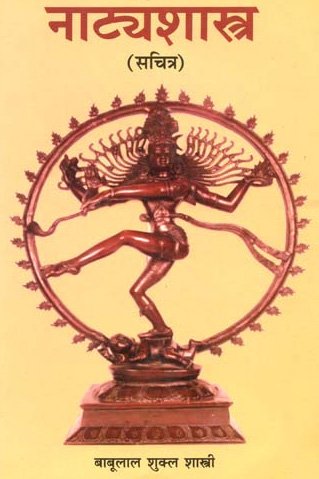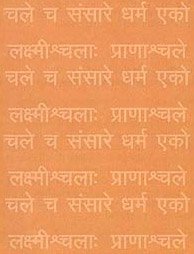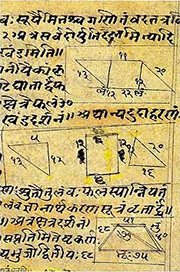Shabala, Śabala, Sabalā, Sabala: 30 definitions
Introduction:
Shabala means something in Buddhism, Pali, Hinduism, Sanskrit, Jainism, Prakrit, Marathi, Hindi. If you want to know the exact meaning, history, etymology or English translation of this term then check out the descriptions on this page. Add your comment or reference to a book if you want to contribute to this summary article.
The Sanskrit term Śabala can be transliterated into English as Sabala or Shabala, using the IAST transliteration scheme (?).
Alternative spellings of this word include Shabal.
Images (photo gallery)
In Hinduism
Natyashastra (theatrics and dramaturgy)
Source: Wisdom Library: Nāṭya-śāstraŚabala (शबल) is the Sanskrit name of one of Bharata’s sons, mentioned in the Nāṭyaśāstra 1.26-33. After Brahmā created the Nāṭyaveda (nāṭyaśāstra), he ordered Bharata to teach the science to his (one hundred) sons. Bharata thus learned the Nāṭyaveda from Brahmā, and then made his sons study and learn its proper application. After their study, Bharata assigned his sons (eg., Śabala) various roles suitable to them.

Natyashastra (नाट्यशास्त्र, nāṭyaśāstra) refers to both the ancient Indian tradition (shastra) of performing arts, (natya—theatrics, drama, dance, music), as well as the name of a Sanskrit work dealing with these subjects. It also teaches the rules for composing Dramatic plays (nataka), construction and performance of Theater, and Poetic works (kavya).
Purana and Itihasa (epic history)
Source: archive.org: Puranic EncyclopediaŚabala (शबल).—A nāga born to Kaśyapaprajāpati of his wife Kadrū. (Ādi Parva, Chapter 85, Verse 7).
Source: Cologne Digital Sanskrit Dictionaries: The Purana Index1a) Śabala (शबल).—A son of Sarama.*
- * Brahmāṇḍa-purāṇa III. 7. 312.
1b) A hell, reached by those who indulge in unrighteous sexual unions*
- * Brahmāṇḍa-purāṇa IV. 2. 147, 158; Vāyu-purāṇa 101. 146, 157.
1c) One of the two dogs of the family of Vaivasvata to whom Bali is to be offered at Gayā.*
- * Vāyu-purāṇa 108. 30; 111. 39.
1d) Sons of Kallolaha.*
- * Brahmāṇḍa-purāṇa III. 7. 442.
1e) The 1000 sons of Dakṣa through Vairiṇī who died in the attempt to get at the measurement of the earth by following their elder brothers.*
- * Matsya-purāṇa 5. 9.
Śabala (शबल) is a name mentioned in the Mahābhārata (cf. I.35.7) and represents one of the many proper names used for people and places. Note: The Mahābhārata (mentioning Śabala) is a Sanskrit epic poem consisting of 100,000 ślokas (metrical verses) and is over 2000 years old.
Source: Shodhganga: Kasyapa Samhita—Text on Visha Chikitsa (itihasa)Śabala is the name of a Serpent (sarpa) mentioned in the thirty-fifth chapter (verses 4-17) of the Ādiparva of the Mahābhārata.—Accordingly, Sauti, on being implored by Śaunaka to name all the serpents in the course of the sarpa-sattra, tells him that it is humanly impossible to give a complete list because of their sheer multiplicity; but would name the prominent ones in accordance with their significance [e.g., Śabala].

The Purana (पुराण, purāṇas) refers to Sanskrit literature preserving ancient India’s vast cultural history, including historical legends, religious ceremonies, various arts and sciences. The eighteen mahapuranas total over 400,000 shlokas (metrical couplets) and date to at least several centuries BCE.
Ayurveda (science of life)
Nighantu (Synonyms and Characteristics of Drugs and technical terms)
Source: WorldCat: Rāj nighaṇṭuŚabala (शबल) is another name for Citraka, a medicinal plant identified with (1) [white variety] Plumbago zeylanica Linn.; (2) [red variety] Plumbago rosea Linn. syn. or Plumbago indica Linn., both from the Plumbaginaceae or “leadwort” family of flowering plants, according to verse 6.43-45 of the 13th-century Raj Nighantu or Rājanighaṇṭu.—The sixth chapter (pippalyādi-varga) of this book enumerates ninety-five varieties of plants obtained from the market (paṇyauṣadhi). Together with the names Śabala and Citraka, there are a total of twenty Sanskrit synonyms identified for this plant.
Unclassified Ayurveda definitions
Source: archive.org: Vagbhata’s Ashtanga Hridaya Samhita (first 5 chapters)Śabala (शबल) is a variant spelling of Śovala and Śaivala (name of a serpent-demon), related to Śaivāla (“tape-grass”), as mentioned in verse 5.6-8 of the Aṣṭāṅgahṛdayasaṃhitā (Sūtrasthāna) by Vāgbhaṭa.—Śaivāla (“tape-grass”) (Vallisneria spiralis L.) has been represented by ña-lcibs, which, according to Mahāvyutpatti 3286, is the name of the serpent-demon Śaivala (v.l. Śovala; Japanese edition: Śabala; Tibetan equivalent: ñi-lcibs). In current Tibetan, it denotes (a) mother of pearl, (b) fish-gills, and (c) a certain medicinal root curative of scalds and blisters; cf. Das, Dict. p. 472.

Āyurveda (आयुर्वेद, ayurveda) is a branch of Indian science dealing with medicine, herbalism, taxology, anatomy, surgery, alchemy and related topics. Traditional practice of Āyurveda in ancient India dates back to at least the first millenium BC. Literature is commonly written in Sanskrit using various poetic metres.
Vedanta (school of philosophy)
Source: Google Books: Sannyasa UpanishadŚabala (शबल) or Śabalabrahma refers to the “pure, resplendent Brahman”, according to the commentary on the Kuṇḍika-upaniṣad verse 28.—The worshippers of the pure, resplendent Brahman (śabala-brahma) enter the world of Brahma (brahmaloka), that is, the sphere of Hiraṇyagarbha, along the path of the Sun (sūryamārga, or uttarāyaṇa-mārga) by exiting from the crown of the head (brahma-randhra) through the suṣumṇā canal; and there they are engaged in their quest for the attributeless Brahman till the end of the kalpa (till pralaya, or great dissolution, takes place). Having lived there till such time, they ultimately merge with Brahman on the attenuation of their subtle desires and attractions (vāsanā-kṣaya). Thereafter they never return to the plane of relative existence. This is the gradual liberation (krama-mukti) attained by the knowers of Brahman with attributes (saviśeṣa brahmajñānī). On the other hand, the knowers of the attributeless, absolute Brahman (nirviśeṣa brahmajñānī) will attain direct, instant liberation (sadyo-mukti), here and now (ihaiva).

Vedanta (वेदान्त, vedānta) refers to a school of orthodox Hindu philosophy (astika), drawing its subject-matter from the Upanishads. There are a number of sub-schools of Vedanta, however all of them expound on the basic teaching of the ultimate reality (brahman) and liberation (moksha) of the individual soul (atman).
Ganitashastra (Mathematics and Algebra)
Source: archive.org: Hindu MathematicsŚabala (शबल) [=śavala?] or Śabalaka refers to the “spotted color” which were used as symbols for the unknowns, according to the principles of Bījagaṇita (“algebra” or ‘science of calculation’), according to Gaṇita-śāstra, ancient Indian mathematics and astronomy.—Āryabhaṭa I (499) very probably used coloured shots to represent unknowns. Brahmagupta (628) in the Brāhmasphuṭasiddhānta mentions varṇa as the symbols of unknowns. As he has not attempted in any way to explain this method of symbolism, it appears that the method was already very familiar. [...] In the case of more unknowns, it is usual to denote the first yāvattāvat and the remaining ones by alphabets or colours [e.g., śabala].—Cf. Pṛthūdakasvāmī (860) in his commentary on the Brāhmasphuṭasiddhānta by Brahmagupta (628) and Bhāskara II in the Bījagaṇita.

Ganitashastra (शिल्पशास्त्र, gaṇitaśāstra) refers to the ancient Indian science of mathematics, algebra, number theory, arithmetic, etc. Closely allied with astronomy, both were commonly taught and studied in universities, even since the 1st millennium BCE. Ganita-shastra also includes ritualistic math-books such as the Shulba-sutras.
In Buddhism
Theravada (major branch of Buddhism)
Source: Pali Kanon: Pali Proper NamesA dog of the Lokantaraniraya. It has iron teeth which it uses on the victims of that Niraya. J.vi.247.
-- or --
. An eminent Theri of Jambudipa, expert in the Vinaya. Dpv.xviii.10.
Theravāda is a major branch of Buddhism having the the Pali canon (tipitaka) as their canonical literature, which includes the vinaya-pitaka (monastic rules), the sutta-pitaka (Buddhist sermons) and the abhidhamma-pitaka (philosophy and psychology).
Mahayana (major branch of Buddhism)
Source: Wisdom Library: Maha Prajnaparamita SastraŚabala (शबल) refers to one of the dogs part of the four utsadas of the Avīci hell according to the “world of transmigration” section in the 2nd century Mahāprajñāpāramitāśāstra (chapter XXVII).—Accordingly, “two evil dogs, Che mo (Śyāma) and Che p’o lo (Śabala), fierce beasts with iron gullets, tear at the sinews and bones of these damned. These dogs are as strong as tigers and as fierce as lions”.

Mahayana (महायान, mahāyāna) is a major branch of Buddhism focusing on the path of a Bodhisattva (spiritual aspirants/ enlightened beings). Extant literature is vast and primarely composed in the Sanskrit language. There are many sūtras of which some of the earliest are the various Prajñāpāramitā sūtras.
In Jainism
General definition (in Jainism)
Source: Wisdom Library: JainismŚabala (शबल).— The śabalas are a group of celestial beings living in the lower regions of adholoka (lower world) according to Jaina cosmology. Adholoka is made up of seven regions and offers residence to the infernal beings existing within these lands.
Source: archive.org: Personal and geographical names in the Gupta inscriptions (jainism)Sabala (सबल, “spotted”) is a Prakrit name indicating defects of the body, representing a rule when deriving personal names as mentioned in the Aṅgavijjā chapter 26. This chapter includes general rules to follow when deriving proper names. The Aṅgavijjā (mentioning sabala) is an ancient treatise from the 3rd century CE dealing with physiognomic readings, bodily gestures and predictions and was written by a Jain ascetic in 9000 Prakrit stanzas.
Source: academia.edu: Tessitori Collection ISabala (सबल) refers to one of the fifteen Paramādhārmīs causing suffering in the hells (naraka), according to Rājasoma’s “Naraka ko coḍhālyo”, which is included in the collection of manuscripts at the ‘Vincenzo Joppi’ library, collected by Luigi Pio Tessitori during his visit to Rajasthan between 1914 and 1919.—No name of any source is given in the text but the three stages followed in the exposition correspond closely to those found in a handbook such as Nemicandrasūri’s Pravacanasāroddhāra, [e.g.,] 3) sufferings inflicted by the fifteen Paramādhārmīs [e.g., Sabala]. [...] These gods (here Sūra or Deva) form a sub-class of the Asurakumāras and perform their tasks in the first, second and third hells.

Jainism is an Indian religion of Dharma whose doctrine revolves around harmlessness (ahimsa) towards every living being. The two major branches (Digambara and Svetambara) of Jainism stimulate self-control (or, shramana, ‘self-reliance’) and spiritual development through a path of peace for the soul to progess to the ultimate goal.
Languages of India and abroad
Pali-English dictionary
Source: BuddhaSasana: Concise Pali-English Dictionarysabala : (adj.) strong; spotted; variegated.
Source: Sutta: The Pali Text Society's Pali-English DictionarySabala, (Vedic śabala (e.g. A. V, 8, 1, 9)=kέrberos, Weber, Ind. Stud. II. 297) spotted, variegated Sn. 675; Vism. 51; VvA. 253; name of one of the dogs in the Lokantara hell J. VI, 106, 247 (Sabálo ca Sāmo ca). asabala, unspotted D. II, 80.

Pali is the language of the Tipiṭaka, which is the sacred canon of Theravāda Buddhism and contains much of the Buddha’s speech. Closeley related to Sanskrit, both languages are used interchangeably between religions.
Marathi-English dictionary
Source: DDSA: The Molesworth Marathi and English Dictionary1) Śabala (शबल).—a S Variegated. 2 Confounded or confusedly intermingled.
śabala (शबल).—n S Confused or tumultuous intermixture.
2) sabala (सबल).—a (S) pop. sabaḷa a Strong, powerful, vigorous.
3) sabaḷa (सबळ).—a See under sabala.
4) sābaḷā (साबळा).—a (Or sābaḍā) Plain, simple, tranquil, gentle; void of forwardness, bustlingness, or meddlesomeness.
Source: DDSA: The Aryabhusan school dictionary, Marathi-English1) Śabala (शबल).—a Variegated. n Confused intermixture.
2) sabala (सबल) [-ḷa, -ळ].—a Strong, powerful, vigorous.
Marathi is an Indo-European language having over 70 million native speakers people in (predominantly) Maharashtra India. Marathi, like many other Indo-Aryan languages, evolved from early forms of Prakrit, which itself is a subset of Sanskrit, one of the most ancient languages of the world.
Sanskrit dictionary
Source: DDSA: The practical Sanskrit-English dictionaryŚabala (शबल).—a. (śap-ala, baśca Uṇādi-sūtra 1.99)
1) Spotted, brindled, variegated; क्वचित् प्रभा चान्द्रमसी तमोभिश्छायाविलीनैः शबलीकृतेव (kvacit prabhā cāndramasī tamobhiśchāyāvilīnaiḥ śabalīkṛteva) R.13.56;5.44; Mv.7.26.
2) Varied, devided into various parts.
3) Articulate; imitative.
4) Mixed; आनन्दशोकशबलत्वमुपैति चेतः (ānandaśokaśabalatvamupaiti cetaḥ) Mālatīmādhava (Bombay) 9.54.
5) Disfigured, pale; चिन्तया शबलं मुखम् (cintayā śabalaṃ mukham) Bhāgavata 6.14.21.
6) Disturbed, afflicted; अत्युत्कण्ठः शबलहृदयोऽस्मद्विधो बाष्पधाराः (atyutkaṇṭhaḥ śabalahṛdayo'smadvidho bāṣpadhārāḥ) Bhāgavata 1.9.2.
-laḥ A variegated colour.
-lā, -lī 1 A spotted or brindled cow.
2) The cow of plenty or Kāmadhenu q. v.
-lam Water.
--- OR ---
Sabala (सबल).—a. Accompanied by a force or army.
Source: Cologne Digital Sanskrit Dictionaries: Edgerton Buddhist Hybrid Sanskrit DictionarySabala (सबल).—name of a nāga king: Mahā-Māyūrī 246.22.
Source: Cologne Digital Sanskrit Dictionaries: Shabda-Sagara Sanskrit-English DictionaryŚabala (शबल).—f. (-lā or lī) A spotted cow.
Source: Cologne Digital Sanskrit Dictionaries: Benfey Sanskrit-English DictionaryŚabala (शबल).—śabala = śavala, q. cf.
--- OR ---
Sabala (सबल).—adj. 1. powerful, strong, [Pañcatantra] i. [distich] 267. 2. with (his) army,
Sabala is a Sanskrit compound consisting of the terms sa and bala (बल).
Source: Cologne Digital Sanskrit Dictionaries: Cappeller Sanskrit-English DictionaryŚabala (शबल).—[adjective] variegated, brindled; mingled or joined with (—°); altered, disfigured. [masculine] [Name] of a serpent-demon; [feminine] śabalī the Wonder-cow (myth.).
--- OR ---
Sabala (सबल).—[adjective] strong, mighty; along with the army.
Source: Cologne Digital Sanskrit Dictionaries: Monier-Williams Sanskrit-English Dictionary1) Śabala (शबल):—mf(ā, or ī)n. (also written śavala; cf. śabara above) variegated, brindled, dappled, spotted (in, [Ṛg-veda x, 14, 10] applied to the two four-eyed watch-dogs of Yama), [Ṛg-veda] etc. etc.
2) variegated by id est. mixed or provided or filled with ([instrumental case] or [compound]), [Kāvya literature; Sarvadarśana-saṃgraha]
3) disfigured, disturbed, [Bhāgavata-purāṇa] (See [compound])
4) m. a variegated colour, [Horace H. Wilson]
5) Name of a serpent-demon, [Mahābhārata]
6) of a man ([varia lectio] for śabara), [Catalogue(s)]
7) f(ā or ī). See below
8) n. water (cf. śabara), [Horace H. Wilson]
9) a [particular] religious observance of the Buddhists, [ib.]
10) Śabalā (शबला):—[from śabala] f. a spotted cow, [cf. Lexicographers, esp. such as amarasiṃha, halāyudha, hemacandra, etc.]
11) [v.s. ...] Name of a cow (Kāmadhenu, the cow of plenty), [Rāmāyaṇa]
12) Sabala (सबल):—[=sa-bala] [from sa > sa-bandha] mfn. (sa-) powerful, strong, [Ṛg-veda] etc. etc.
13) [v.s. ...] together with strength or power, [cf. Lexicographers, esp. such as amarasiṃha, halāyudha, hemacandra, etc.]
14) [v.s. ...] accompanied by a force or army, [Mahābhārata; Rāmāyaṇa]
15) [v.s. ...] together with Bala (Kṛṣṇa’s eldest brother), [Bhāgavata-purāṇa]
16) [v.s. ...] m. Name of a son of Manu Bhautya, [Harivaṃśa]
17) [v.s. ...] of a son of Vasiṣṭha (and one of the 7 Ṛṣis), [Mārkaṇḍeya-purāṇa]
18) [v.s. ...] of one of the 7 Ṛṣis under Manu Sāvarṇa, [ib.]
Source: DDSA: Paia-sadda-mahannavo; a comprehensive Prakrit Hindi dictionary (S)Śabala (शबल) in the Sanskrit language is related to the Prakrit word: Sabala.
[Sanskrit to German]
Sanskrit, also spelled संस्कृतम् (saṃskṛtam), is an ancient language of India commonly seen as the grandmother of the Indo-European language family (even English!). Closely allied with Prakrit and Pali, Sanskrit is more exhaustive in both grammar and terms and has the most extensive collection of literature in the world, greatly surpassing its sister-languages Greek and Latin.
Hindi dictionary
Source: DDSA: A practical Hindi-English dictionary1) Śabala (शबल) [Also spelled shabal]:—(a) variegated, diverse; ~[tā] variegatedness, diverseness.
2) Sabala (सबल) [Also spelled sabal]:—(a) strong, forceful/powerful; valid; [tā] strength, forcefulness/powerfulness.
...
Prakrit-English dictionary
Source: DDSA: Paia-sadda-mahannavo; a comprehensive Prakrit Hindi dictionarySabala (सबल) in the Prakrit language is related to the Sanskrit word: Śabala.
Prakrit is an ancient language closely associated with both Pali and Sanskrit. Jain literature is often composed in this language or sub-dialects, such as the Agamas and their commentaries which are written in Ardhamagadhi and Maharashtri Prakrit. The earliest extant texts can be dated to as early as the 4th century BCE although core portions might be older.
Kannada-English dictionary
Source: Alar: Kannada-English corpusŚabala (ಶಬಲ):—
1) [adjective] having different colours in different parts; parti-coloured; variegated.
2) [adjective] marked with spots; spotted.
--- OR ---
Śabala (ಶಬಲ):—
1) [noun] the fact of something being painted with or made of different colours.
2) [noun] that which is marked with spots; a spotted thing.
3) [noun] something made by mixing (of different things) a mixture.
--- OR ---
Śabaḷa (ಶಬಳ):—[adjective] = ಶಬಲ [shabala]1.
--- OR ---
Śabaḷa (ಶಬಳ):—[noun] = ಶಬಲ [shabala]2.
--- OR ---
Sabala (ಸಬಲ):—
1) [adjective] having strength; able to exert muscular power; strong.
2) [adjective] having, assisted by, an army.
--- OR ---
Sabala (ಸಬಲ):—[noun] a strong, powerful man.
--- OR ---
Sabaḷa (ಸಬಳ):—
1) [noun] a weapon, consisting of a long wooden or metal shaft having a pointed end, used to throw at or thrust; a spear.
2) [noun] (hist.) a monetary coin having a symbol of a spear stamped on it.
Kannada is a Dravidian language (as opposed to the Indo-European language family) mainly spoken in the southwestern region of India.
See also (Relevant definitions)
Partial matches: Bala, Sha, Ca.
Starts with: Shabalabrahma, Shabalacetana, Shabalagu, Shabalahridaya, Shabalaka, Shabalaksha, Shabalashva, Shabalata, Shabalate, Shabalateveru, Shabalatva, Shabalaya.
Ends with: Asabala, Bhavashabala, Dasabala, Harikeshabala, Ishabala, Krishnashabala, Lohitashabala, Nishabala, Pakshabala, Paramarshabala, Sarangashabala, Sarvavastushabala, Shyamashabala.
Full-text (+67): Savala, Shabalata, Sabalanuga, Shabalita, Shabalatva, Savara, Shabaliya, Shabalaksha, Sabalika, Shabalikrita, Asabala, Shabalate, Sabalasimha, Shabalashva, Sabalavahana, Shabalaka, Sabalabhabala, Shabalahridaya, Shabalagu, Sabalagadyana.
Relevant text
Search found 29 books and stories containing Shabala, Śabala, Sabalā, Sabala, Sābaḷā, Sabaḷa, Sābalā, Sa-bala, Śabalā, Śabaḷa; (plurals include: Shabalas, Śabalas, Sabalās, Sabalas, Sābaḷās, Sabaḷas, Sābalās, balas, Śabalās, Śabaḷas). You can also click to the full overview containing English textual excerpts. Below are direct links for the most relevant articles:
Chandogya Upanishad (english Translation) (by Swami Lokeswarananda)
Verse 8.13.1 < [Section 8.13]
Ramayana of Valmiki (by Hari Prasad Shastri)
Chapter 54 - King Vishvamitra attempts to carry Shabala away by force < [Book 1 - Bala-kanda]
Chapter 53 - King Vishvamitra king desires to possess Shabala < [Book 1 - Bala-kanda]
Chapter 55 - Shabala creates an army which annihilates Vishvamitra’s forces < [Book 1 - Bala-kanda]
Ramayana (by Manmatha Nath Dutt)
Chapter LIII < [Book 1 - Bāla-kāṇḍa]
Chapter LIV < [Book 1 - Bāla-kāṇḍa]
Chapter LII < [Book 1 - Bāla-kāṇḍa]
Chandogya Upanishad (Madhva commentary) (by Srisa Chandra Vasu)
Puranic encyclopaedia (by Vettam Mani)
Amarakoshodghatana of Kshirasvamin (study) (by A. Yamuna Devi)
Fauna (5): Domesticated animals (d): Cow < [Chapter 5 - Aspects of Nature]
Related products
